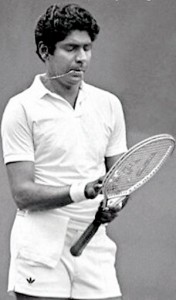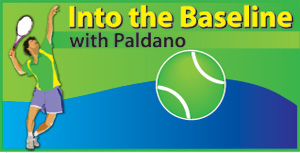Success of India- doubles
 India’s Tennis legacy is impressive as an Asian nation. Many will recall Indian Ramanathan Krishnan as a Grand-Slam semi-finalist and Vijay Amritaj as a Wimbledon quarter-finalist in singles and good many results in Doubles over the last 50 years. We note, however, that India’s Grand-Slam winners are Doubles players and one has to give credit to India for this achievement. Modern global Tennis is professional and it is over-challenging our capacity physically to excel in Singles. To overcome this Indians have made the right choice playing Doubles and have achieved good results consistently.
India’s Tennis legacy is impressive as an Asian nation. Many will recall Indian Ramanathan Krishnan as a Grand-Slam semi-finalist and Vijay Amritaj as a Wimbledon quarter-finalist in singles and good many results in Doubles over the last 50 years. We note, however, that India’s Grand-Slam winners are Doubles players and one has to give credit to India for this achievement. Modern global Tennis is professional and it is over-challenging our capacity physically to excel in Singles. To overcome this Indians have made the right choice playing Doubles and have achieved good results consistently.
Switzerland’s Martina Hingis was an impressive world’s singles number one and has a commanding position to select a partner for doubles and she has opted for Indian partners. She won titles at the Grand Slams this year with Sanya Mirza in doubles and Leander Peas in mixed-doubles, thus making India ‘the land of Tennis Doubles’. Rohan Bopanna is another Indian who has made his presence felt through doubles. India reached the finals of the Davis-Cup in the late sixties and the secret of their successes, no doubt, were their Doubles combinations. In the wooded racquet era, I recall witnessing Ramanathan Krishnan and Jaideep Mukerji beating Brazil’s Thomas Koch and Edison Mandarino on grass courts at the Calcutta South Club to reach the finals in a tantalizing match.
Mastering singles via Doubles
Traditionally, Tennis players are known for their singles and too often being a good singles player is more of an obsession than a rational pursuit. This has made singles participation an automated choice. Unfortunately in the last thirty to forty years corresponding success do not seem to follow taking this traditional route. In many ways doing the same thing and expecting different result is not smart at all. The Indian choice to turn the head into doubles has many virtues and advantages even for Sri Lankan players.
Tennis traditionally being a fiercely individual game, we have been developing players for Singles, ignoring Doubles. Evaluation of our national Tennis shows this to be a folly. In addition, for the sake of Singles, the focus on top-spin based ground strokes has killed the all-court-skill development which in effect has also limited our tactical approach and retarded our reaction speed. The end effect is that the players with such a grip can only play from the baseline or even from further back. These extreme grips curtail players from developing alternate all-court tactics in singles. It becomes a limitation at the higher end of competition.
 In the tropical belt, the Asian physical makeup is better suited for an all-court game than a strong baseline game. All court game relies on speed, suppleness and touch more than strength. For this reason the best development approach for us is to be an all-court-player. Doubles at an early age orients a player to play from within the court and develop three vital ingredients needed for singles play. One, using the body weight for power in ground-strokes instead of long swing; second, inducing early sighting for time advantage; and third, developing rapid reaction to accommodate the high speed of the modern game. It is easy to get ‘stuck’ in singles without progressing if you have only a baseline game only. It is happening to Denmark’s former world’s number one Caroline Wozniacki and to a good extent to current number two Romania’s Simona Halep at the high end of the world rankings.
In the tropical belt, the Asian physical makeup is better suited for an all-court game than a strong baseline game. All court game relies on speed, suppleness and touch more than strength. For this reason the best development approach for us is to be an all-court-player. Doubles at an early age orients a player to play from within the court and develop three vital ingredients needed for singles play. One, using the body weight for power in ground-strokes instead of long swing; second, inducing early sighting for time advantage; and third, developing rapid reaction to accommodate the high speed of the modern game. It is easy to get ‘stuck’ in singles without progressing if you have only a baseline game only. It is happening to Denmark’s former world’s number one Caroline Wozniacki and to a good extent to current number two Romania’s Simona Halep at the high end of the world rankings.
Sri Lanka’s Scarnival & Fonseka
All our good past players were good at Doubles. Bernard Pinto, Rupert Ferdinands, P S Kumara, D.D.N Selvadurai, Ranjan Wattegedera, Arjun Fernando, Suresh Sivagnanam, Rohan de Silva, Rajiv Rajapakse and our current best Harshana Godamanne being excellent in doubles. Harshana has carried our Davis cup to great wins with his capacity to play very good doubles. Not many will know and is often forgotten that only our doubles players have ever played in a Grand-Slam event – Douglas Scarnival and Douglas Fonseka played Wimbledon Doubles many years ago. We have to take their example as our key to player development. Something has to change in our development and the pointer to our change is Scarnival and Fonseka’s performance- Doubles before Singles.
Reaction, vital ingredient
The language of sport is reaction and has been so in all ages. The all-court play is the secret to acquire this. Even at a late stage and at a late age the ever so successful Roger Federer in his quest to be perfect and an eternal student of the game has employed Stefan Edberg an all-court player to be his coach. It is a great example to every player who has a Tennis racquet in hand.
India’s Sanya Mirza is the first Indian female to feature in a Grand-Slam title winners’ list. Sanya with Leander Paes, Mahesh Bhupathy, Rohan Bopanna were little known singles players but now with outstanding Grand-Slam performances in Doubles, their names will echo with those of Ramanathan Kishnan and Vijay Amritaj for generations to come. In any activity there comes a point in time where one will have to learn from others to improve. Sri Lanka’s Tennis is at that point now.
George Paldano, international player; Accredited Coach of Germany; National, Davis Cup, Federation Cup, Qualified coach–. gptennis.ceylon@gmail.com


